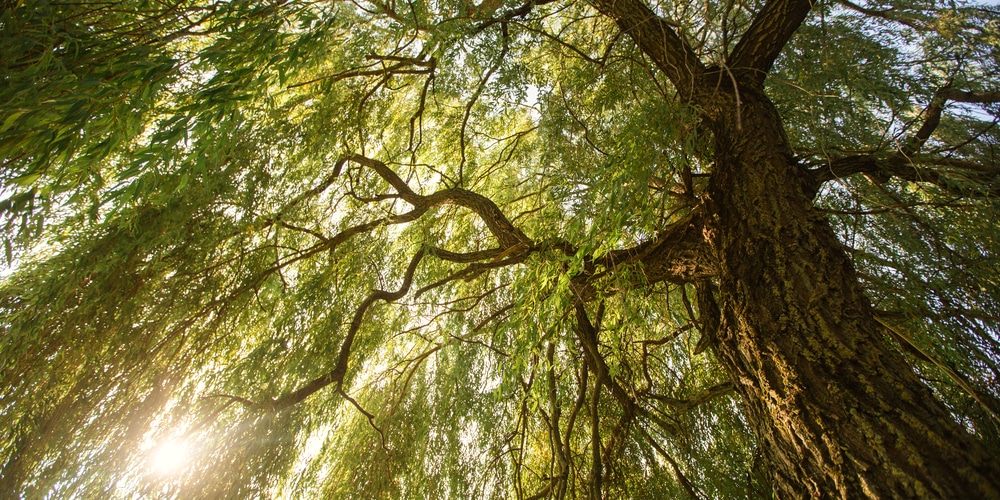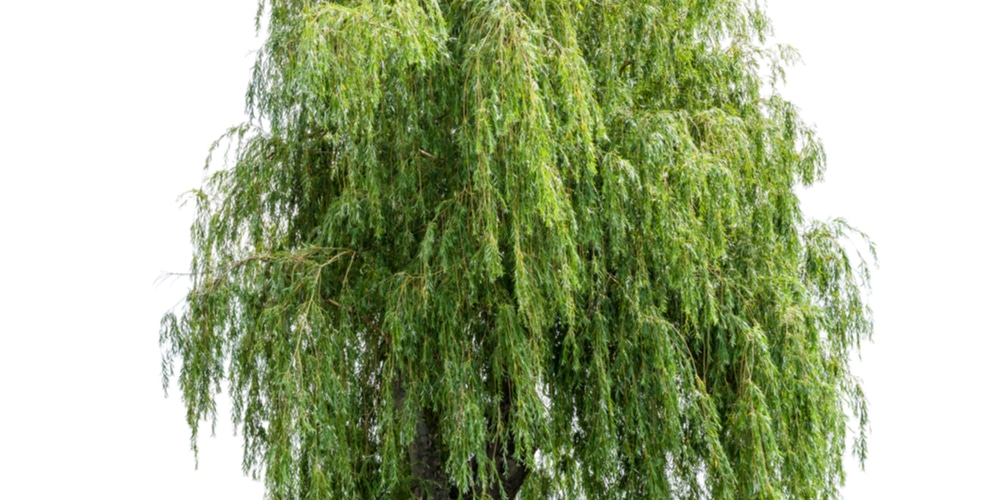Weeping willow trees, or the salix babylonica, are beautiful medium to large trees that originate from East Asia. These trees can reach heights of up to 40 feet, and the crowns can extend outward 30 to 40 feet or more. A weeping willow’s shallow root system can extend up to 100 feet or more from the tree’s trunk. The weeping willow grows best in hardiness zones six to eight, prefers sunlight and shade, and likes well-drained soil. These are things to think about if you’re thinking of planting a weeping willow. Let’s take a look at some weeping willow tree pros and cons to see if this tree is right for your yard.
Pros

Here are some positive things about adding weeping willow trees to your yard.
Their Appearance
The weeping willow gets its name from its curved and drooping branches that can grow down to the ground, creating a canopy. This cascading tree offers an appearance of elegance, and it even produces flowers in the spring to brighten up your yard.
In the fall, the leaves of weeping willows start changing into hues of golden yellow and orange. Then when the winter rolls in, the leaves will start falling off the tree. You can expect foliage to begin growing again in the spring when you’ll see catkins start budding. These cylindrical clusters of flowers will offer beautiful yellow hues to your yard.
Weeping Willows Are Easy To Take Care of and Grow Fast
Weeping willow trees are adaptable and will grow in most soil types. The weeping willow can grow just fine in the following soils:
- Acidic or alkaline
- Loam
- Moist or sandy
- Clay soil
The tree does better when you plant it near a water source, but it’s slightly drought tolerant, so it can handle dryness.
The weeping willow also has a high growth rate compared to other trees, as it can grow up to ten feet per year.
Canopy Shade
Sometimes the crown of the weeping willow can go over 40 feet, offering a large area of shade beneath the tree. Along with this, the leaves of the weeping willow grow closely together. This thick leaf coverage leaves almost no room for sunlight to shine through the canopy, creating solid shade.
Cons
Here are some negative things to keep in mind if you are contemplating planting a weeping willow tree in your yard.
Invasive Root Systems
The root systems of weeping willows can grow well over 100 feet, causing them to damage underground water and sewage pipes, and crack building foundations and pavement. Never plant them near your home, inground pools, or other structures because of this. Or, you can use root barriers to block the roots from causing damage.
Weeping Willows Can Get Diseases and Insect Pests
The moist, shady environments that weeping willows provide are prime breeding grounds for diseases and pests. Insects such as aphids, various caterpillars, moths, beetles, scales, and lace bugs like to nest in weeping willows. These bugs will eat the leaves and dig their way through the trunk and branches. As a result, the tree will become weak, break, and die.
Diseases that are common in weeping willows include:
- Blight and other funguses
- Cankers
- Leaf spot diseases
Foliage Littering
The trees will litter your yard with leaves, flowers, weak twigs, and branches. Weeping Willows lose all their leaves in the winter. You can expect to be cleaning up after these trees daily, as they constantly shed. If you live in an area that frequently gets strong storms, you can expect larger tree limbs to litter your yard.
Conclusion
Weeping willows can make beautiful additions to your yard, lasting up to 30 years, but it’s difficult to decide if the tree is right for you and your yard. Use these weeping willow tree pros and cons to help you decide if a weeping willow is something you’d like to plant.
